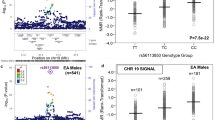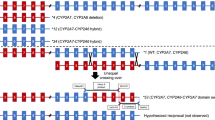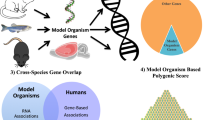Abstract
Although it has been documented that dynamin 1 gene (DNM1) is significantly modulated by nicotine in animal models, its association with nicotine dependence (ND) in human population remained to be unexplored. To determine whether DNM1 is associated with ND, in this study, we genotyped seven single-nucleotide polymorphisms (SNPs) within this gene in 602 nuclear families of either African-American (AA) or European-American (EA) origin. Individual SNP-based association analysis revealed a significant association of SNP rs3003609 with smoking quantity (SQ; P=0.0031) and Heaviness of Smoking Index (HSI; P=0.0042) in the EA sample. Furthermore, our haplotype-based association analyses indicated that haplotypes T-G-T, formed by rs2502731-rs2229917-rs3003609 (at a frequency of 54%), G-T-A, formed by rs2229917-rs3003609-rs16930313 (at a frequency of 52%), and T-A-G, formed by rs3003609-rs16930313-rs7022174 (at a frequency of 52%) are significantly associated with SQ (Z=−2.44 to −2.92; P=0.015–0.0055) and HSI (Z=−2.52 to −2.67; P=0.012-0.0076) in the EA sample. In the AA sample, another haplotype, G-T-A, formed by rs7875406-rs2502731-rs2229917, at a frequency of 12% was significantly associated with SQ (Z=−2.58; P=0.0098). Finally, by using in vitro gene expression assays, we demonstrated that the T allele of rs3003609 in the exon 9 of DNM1 significantly decreases the expression of DNM1, by 27.1% at the mRNA and 22.0% at the protein level, suggesting that rs3003609 represents a functional polymorphism affecting DNM1 expression and may partly contributed to the observed association of the gene with ND in our samples. Taken together, our findings indicate that DNM1 is likely involved in the etiology of ND and represents a plausible candidate for further investigation in independent samples.
Similar content being viewed by others
Log in or create a free account to read this content
Gain free access to this article, as well as selected content from this journal and more on nature.com
or
References
Barrett JC, Fry B, Maller J, Daly MJ (2005). Haploview: analysis and visualization of LD and haplotype maps. Bioinformatics 21: 263–265.
Benowitz NL, Perez-Stable EJ, Fong I, Modin G, Herrera B, Jacob III P (1999). Ethnic differences in N-glucuronidation of nicotine and cotinine. J Pharmacol Exp Ther 291: 1196–1203.
Carmelli D, Swan GE, Robinette D, Fabsitz R (1992). Genetic influence on smoking—a study of male twins. N Engl J Med 327: 829–833.
Ferguson SM, Brasnjo G, Hayashi M, Wolfel M, Collesi C, Giovedi S et al (2007). A selective activity-dependent requirement for dynamin 1 in synaptic vesicle endocytosis. Science 316: 570–574.
Frank S, Gaume B, Bergmann-Leitner ES, Leitner WW, Robert EG, Catez F et al (2001). The role of dynamin-related protein 1, a mediator of mitochondrial fission, in apoptosis. Dev Cell 1: 515–525.
Gabriel SB, Schaffner SF, Nguyen H, Moore JM, Roy J, Blumenstiel B et al (2002). The structure of haplotype blocks in the human genome. Science 296: 2225–2229.
Heatherton TF, Kozlowski LT, Frecker RC, Fagerstrom KO (1991). The Fagerstrom test for nicotine dependence: a revision of the Fagerstrom Tolerance Questionnaire. Br J Addict 86: 1119–1127.
Hislop JN, Everest HM, Flynn A, Harding T, Uney JB, Troskie BE et al (2001). Differential internalization of mammalian and non-mammalian gonadotropin-releasing hormone receptors. Uncoupling of dynamin-dependent internalization from mitogen-activated protein kinase signaling. J Biol Chem 276: 39685–39694.
Horvath S, Xu X, Lake SL, Silverman EK, Weiss ST, Laird NM (2004). Family-based tests for associating haplotypes with general phenotype data: application to asthma genetics. Genet Epidemiol 26: 61–69.
Hwang YY, Li MD (2006). Proteins differentially expressed in response to nicotine in five rat brain regions: identification using a 2-DE/MS-based proteomics approach. Proteomics 6: 3138–3153.
Jiang S, Avraham HK, Kim TA, Rogers RA, Avraham S (2006). Receptor-type PTP-NP inhibition of Dynamin-1 GTPase activity is associated with neuronal depolarization. Cell Signal 18: 1439–1446.
Kashiwakura Y, Watanabe M, Kusumi N, Sumiyoshi K, Nasu Y, Yamada H et al (2004). Dynamin-2 regulates oxidized low-density lipoprotein-induced apoptosis of vascular smooth muscle cell. Circulation 110: 3329–3334.
Kelly BL, Ferreira A (2006). beta-Amyloid-induced dynamin 1 degradation is mediated by N-methyl-D-aspartate receptors in hippocampal neurons. J Biol Chem 281: 28079–28089.
Kimchi-Sarfaty C, Oh JM, Kim IW, Sauna ZE, Calcagno AM, Ambudkar SV et al (2007). A ‘silent’ polymorphism in the MDR1 gene changes substrate specificity. Science 315: 525–528.
Kitzmueller E, Krapfenbauer K, Hoeger H, Weitzdoerfer R, Lubec G, Lubec B (2004). Life-long effects of perinatal asphyxia on stress-induced proteins and dynamin 1 in rat brain. Neurochem Res 29: 1767–1777.
Koenig JH, Ikeda K (1989). Disappearance and reformation of synaptic vesicle membrane upon transmitter release observed under reversible blockage of membrane retrieval. J Neurosci 9: 3844–3860.
Lange C, Silverman EK, Xu X, Weiss ST, Laird NM (2003). A multivariate family-based association test using generalized estimating equations: FBAT-GEE. Biostatistics 4: 195–206.
Li MD (2006). The genetics of nicotine dependence. Curr Psychiatry Rep 8: 158–164.
Li MD, Cheng R, Ma JZ, Swan GE (2003). A meta-analysis of estimated genetic and environmental effects on smoking behavior in male and female adult twins. Addiction 98: 23–31.
Mokdad AH, Marks JS, Stroup DF, Gerberding JL (2004). Actual causes of death in the United States, 2000. JAMA 291: 1238–1245.
Nackley AG, Shabalina SA, Tchivileva IE, Satterfield K, Korchynskyi O, Makarov SS et al (2006). Human catechol-O-methyltransferase haplotypes modulate protein expression by altering mRNA secondary structure. Science 314: 1930–1933.
Nyholt DR (2004). A simple correction for multiple testing for single-nucleotide polymorphisms in linkage disequilibrium with each other. Am J Hum Genet 74: 765–769.
O'Connell JR, Weeks DE (1998). PedCheck: a program for identification of genotype incompatibilities in linkage analysis. Am J Hum Genet 63: 259–266.
Powell KA, Robinson PJ (1995). Dephosphin/dynamin is a neuronal phosphoprotein concentrated in nerve terminals: evidence from rat cerebellum. Neuroscience 64: 821–833.
Praefcke GJ, McMahon HT (2004). The dynamin superfamily: universal membrane tubulation and fission molecules? Nat Rev Mol Cell Biol 5: 133–147.
Schmid SL, McNiven MA, De Camilli P (1998). Dynamin and its partners: a progress report. Curr Opin Cell Biol 10: 504–512.
Sontag JM, Fykse EM, Ushkaryov Y, Liu JP, Robinson PJ, Sudhof TC (1994). Differential expression and regulation of multiple dynamins. J Biol Chem 269: 4547–4554.
Stolerman IP, Jarvis MJ (1995). The scientific case that nicotine is addictive. Psychopharmacology (Berl) 117: 2–10; discussion 14–20.
Swan GE, Hudmon KS, Jack LM, Hemberger K, Carmelli D, Khroyan TV et al (2003). Environmental and genetic determinants of tobacco use: methodology for a multidisciplinary, longitudinal family-based investigation. Cancer Epidemiol Biomarkers Prev 12: 994–1005.
Swan GE, Lessov CN (2004). Gene–environment interaction in nicotine addiction: the need for a large-scale, collaborative effort. Subst Use Misuse 39: 2083–2085.
Torre E, McNiven MA, Urrutia R (1994). Dynamin 1 antisense oligonucleotide treatment prevents neurite formation in cultured hippocampal neurons. J Biol Chem 269: 32411–32417.
USDHHS (2000). Reducing Tobacco Use: A report of the Surgeon General. US Department of Health & Human Services, Center for Disease Control and Prevention, National Center for Chronic Disease Prevention and Health Promortion: Atlanta, Georgia.
Wang J, Gutala R, Hwang YY, Kim JM, Konu O, Ma JZ et al (2008). Strain- and region-specific gene expression profiles in mouse brain in response to chronic nicotine treatment. Genes Brain Behav 7: 78–87.
WHO (2002). The World Health Report 2002. World Health Organization: Geneva, Switzerland.
Yamashita T, Hige T, Takahashi T (2005). Vesicle endocytosis requires dynamin-dependent GTP hydrolysis at a fast CNS synapse. Science 307: 124–127.
Yampolsky LY, Kondrashov FA, Kondrashov AS (2005). Distribution of the strength of selection against amino acid replacements in human proteins. Hum Mol Genet 14: 3191–3201.
Acknowledgements
We are grateful to the invaluable contributions of clinical information and tissue samples by the participants in this study, as well as the dedicated work of the research staffs at different clinical sites. We also thank Dr David L Bronson for his excellent editing of this paper. This project was funded by National Institutes of Health grants DA-12844 and DA-13783 (to MDL).
Author information
Authors and Affiliations
Corresponding author
Additional information
DISCLOSURE/CONFLICT OF INTEREST
QX, WH, TJP, and JZM have no conflicts of interest to declare. MDL disclosed consulting fees on a NIDA-sponsored research project from Information Management Consultants Inc.
Rights and permissions
About this article
Cite this article
Xu, Q., Huang, W., Payne, T. et al. Detection of Genetic Association and a Functional Polymorphism of Dynamin 1 Gene with Nicotine Dependence in European and African Americans. Neuropsychopharmacol 34, 1351–1359 (2009). https://doi.org/10.1038/npp.2008.197
Received:
Revised:
Accepted:
Published:
Issue date:
DOI: https://doi.org/10.1038/npp.2008.197
Keywords
This article is cited by
-
Converging findings from linkage and association analyses on susceptibility genes for smoking and other addictions
Molecular Psychiatry (2016)
-
The contribution of rare and common variants in 30 genes to risk nicotine dependence
Molecular Psychiatry (2015)
-
MicroRNAs in addiction: adaptation's middlemen?
Molecular Psychiatry (2011)
-
Breaking Barriers in the Genomics and Pharmacogenetics of Drug Addiction
Clinical Pharmacology & Therapeutics (2010)
-
Common and Unique Biological Pathways Associated with Smoking Initiation/Progression, Nicotine Dependence, and Smoking Cessation
Neuropsychopharmacology (2010)



